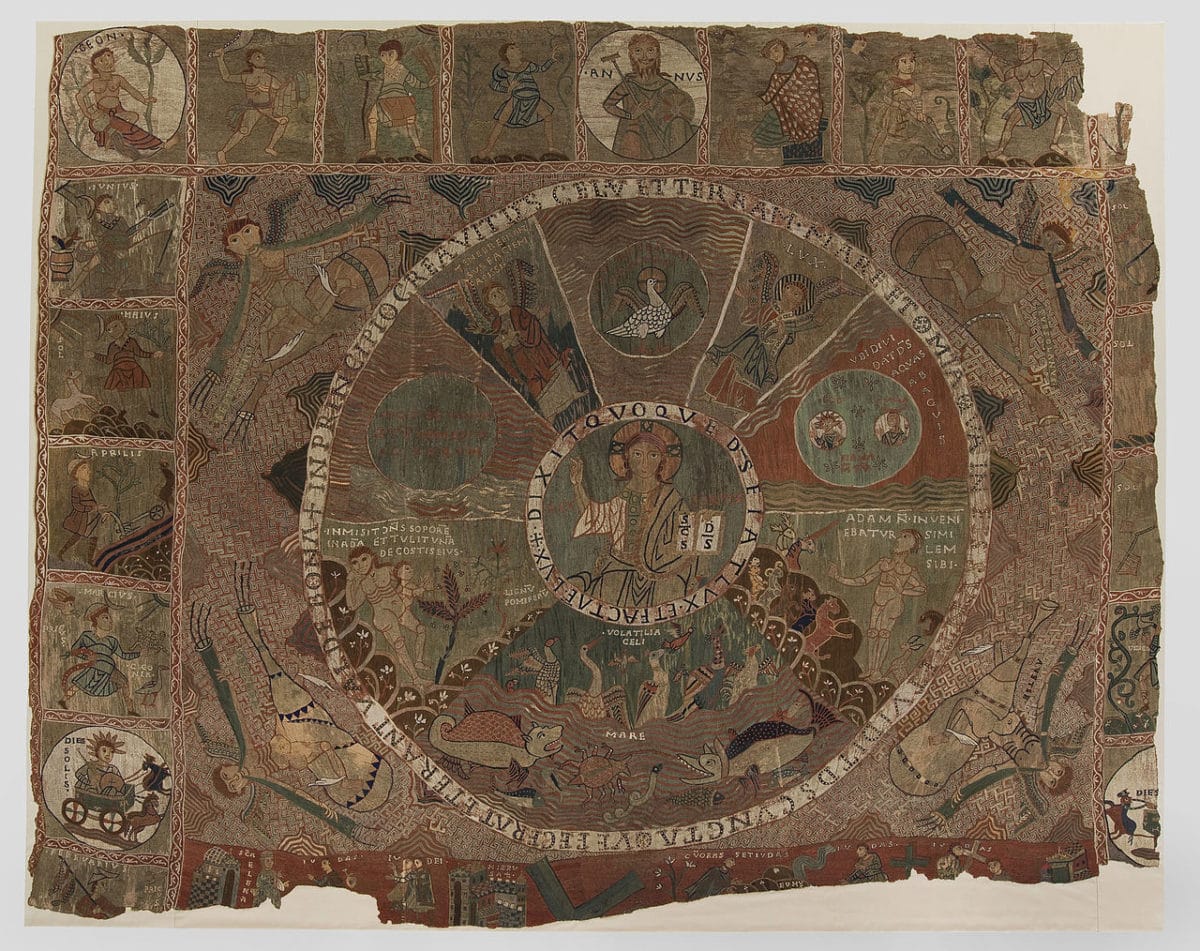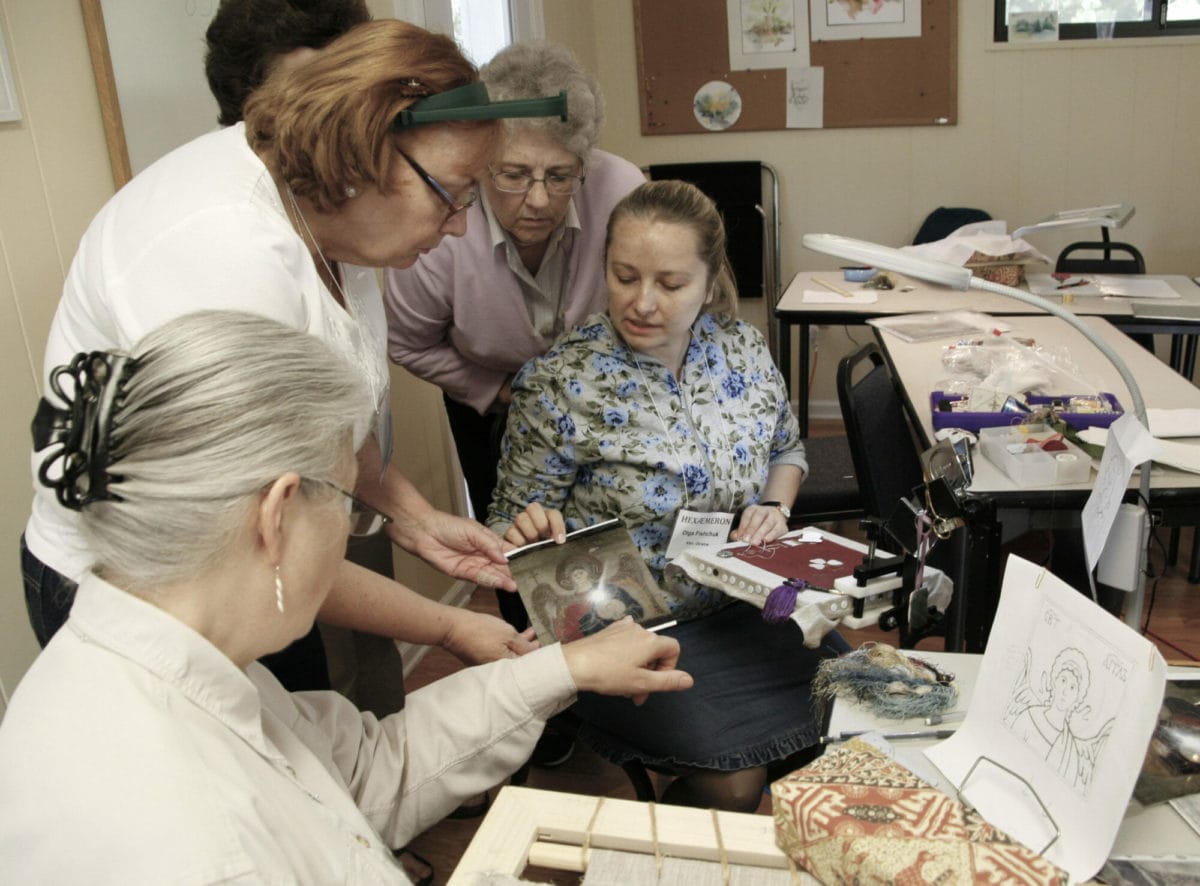Similar Posts
I would like to introduce you to my new project, Katrusya Studio, which was established to teach people Medieval ecclesial pictorial embroidery.
What is pictorial embroidery?
The term “pictorial embroidery” refers to any embroidery depicting faces and figures of people. Ecclesial pictorial embroidery encompasses figures of saints, scenes from their lives, and famous historical events. The roots of this type of embroidery go back to very ancient times. We know of its existence not just from surviving embroideries, which, being perishable, are very rare, but also other art forms–sculpture, carved bone or etched metals, wall paintings, mosaics that depict people wearing embroidered clothing. The Hebrew Bible, in describing the ancient Jewish temple, mentions a textile with images of cherubim.
Since early Christian times, pictorial embroidery was used in place of icon painting in situations where there was a need for materials more flexible and lightweight than wood and metal. These included icons used for worship services while armies or rulers were traveling in areas without churches, processional banners, and shrouds for use during Holy Week. It has also been widely used to decorate the walls and altars of churches, to adorn church vestments, to grace wealthy homes, and to enhance precious secular clothing.

A circular medallion depicting the meeting of the Virgin Mary and her cousin Elizabeth, the mother of St. John the Baptist, and also depicting the Annunciation. VII – VIII centuries AD.

The Girona Tapestry or Tapestry of Creation, a large embroidered piece done in Catalonia in the early XII century.
The artists of Byzantium are widely regarded as among the most skilled during the medieval period. All of their church arts–architecture, painting, fresco, sculpture, mosaic, and embroidery–were of the highest quality and used the finest materials. With the fall of Byzantium in 1453, the empire’s artisans scattered abroad. Many of them made their way to Rome and other areas in Europe, where they continued to work for churches and wealthy patrons. The embroidery techniques developed in Byzantium thus were preserved in the Christian world, where they continued to evolve.

The so-called “Dalmatic of Charlemagne,” probably executed in Byzantium in the second half of the XIV century.
About the project
The project will offer students master classes at three levels:
The first level is an introduction to the basic methods and techniques of embroidery which were used in the Middle Ages, using examples of simple, mostly ornamental compositions. Master classes at the introductory level will be interesting not only to those who want to learn ecclesial embroidery, but also to any embroiderers who want to improve and expand their knowledge and skills.
The intermedia level involves the execution of icons with simple embroidered faces.
The advanced level is the embroidery of more complex waist and full height icons with embroidered faces and hands.
In addition to the actual master classes, the project will also offer students lectures on the history of pictorial embroidery in the medieval style, as well as other interesting and useful materials. Since the master classes are designed for independent learning of the material by students, the instructions are very detailed, with a great many photos and diagrams, as well as videos of the process.
About the first master class
Currently, the introductory-level master class «Flower and Vine” is ready and can be purchased here.
It introduces students to the basic techniques of embroidery with silk and gold and decoration of embroidery with pearls.
The teaching material includes more than 70 pages of text with 70 pictures and 16 videos.
This master class is designed for master embroiderers who already have some experience, and is not suitable for complete beginners.
Its main goal is to give students an idea of the basic techniques that were most often used in ancient embroidered works, and to teach them to work correctly using these techniques, with a high level of quality, so that in the master classes at the next level they can focus on more complex technical tasks, such as face, hands, and body embroidery.
Who is this master class for?
This class is for anyone who is interested in hand embroidery, already has basic embroidery skills, and wants to master techniques of pictorial and gold embroidery that have been used for many centuries.
The skills taught in this class can be used for church embroideries, including embroidered icons, wall hangings, covers for tables and icon stands, covers for chalices, processional banners, bishops’ miters, bookmarks for Gospel and Epistle books, and vestments.
There are also non-religious fields where these techniques can be applied:
- reconstruction of historical garments
- creating textiles in the ancient style
- decorating contemporary clothing with gold
- creating embroideries for decorating interiors
About the author
My name is Olga Fishchuk. I am a professional embroiderer and embroidery teacher.
In 2005 I left my job as a journalist at a well-known Kyiv (Ukraine) newspaper and went to study pictorial embroidery at the icon-painting school within the Trinity Sergius Monastery near Moscow. At that time, it was almost the only place where you could get such an education.
Over the course of four years at this school, I received theoretical and practical training, including opportunities to perform extensive research in rich museum collections. I accumulated invaluable knowledge and the skills for creating unique works using ancient embroidery techniques. Since then, I have been refining my skills by creating a wide variety of commissioned pieces.
You can see many more examples of my work on my blog: “Hand Embroidery in the Medieval Style.”
I am now eager to share my experience with students.
For several years before the pandemic, I taught in-person embroidery courses in Ukraine, the Netherlands and the USA. In particular, in the USA, for three years in a row, I taught embroidery in person at the Hexaemeron ecclesial arts workshops, for which I am indebted to Mrs. Mary Lowell, the founder and manager of this organization.
Though travel is no longer restricted because of the pandemic, the war against Ukraine has made it impossible for me to travel for teaching. Those who took my classes, and others who did not have the opportunity to attend them, asked me to create teaching materials suitable for individual self-study. So, while living under fire in Kyiv with my young daughter, I have created the Katrusya Studio project to instruct those who wish to study one of the most sophisticated embroidery styles, and one of great historical importance.
Twenty percent of the income from sales of this master class will be used to purchase hemostatic tourniquets, bone implants and other necessary medical materials for wounded Ukrainian soldiers.
If you enjoyed this article, please use the donate button at the bottom of the page to support the work of the Orthodox Arts Journal. The costs to maintain the website are considerable.










What a great opportunity to learn an ancient, beautiful art form!